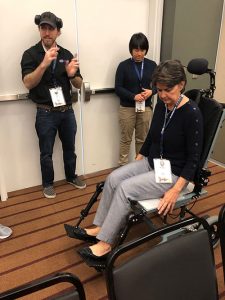Clinician Interview with Missy Ball – Movement and Development
Michelle L. Lange, OTR/L, ATP/SMS
 In our last blog, I interviewed Missy Ball regarding her experiences with Dynamic Seating. In this blog, I would like to share some of her thoughts on Movement, Development, and Function. Missy has written two articles on the topic of Dynamic Seating for Convaid which discuss this interrelationship. The text below is taken from the first of these articles, “Part 1: Dynamic Seating Generally Speaking.”
In our last blog, I interviewed Missy Ball regarding her experiences with Dynamic Seating. In this blog, I would like to share some of her thoughts on Movement, Development, and Function. Missy has written two articles on the topic of Dynamic Seating for Convaid which discuss this interrelationship. The text below is taken from the first of these articles, “Part 1: Dynamic Seating Generally Speaking.”
Motor Development
“In motor development, children learn to manage their bodies in gravity through moving in gravity. Experience is the sculptor of the brain. Trial and error are essential to forge effective neuropathways.”
Bottom Line: Children learn to move by moving. In clients with limited mobility, static seating reduces learning opportunities.
Balancing Stability and Movement for Function
“Finding the key between stability and movement is critical for function. Motor function is the dynamic interplay between posture and movement. Posture is both stability and orientation. One maintains the body’s center of mass within specific boundaries in space (stability) while the other properly relates body parts to each other and the environment for a specific task (orientation). Stability does not mean static, but often does when a client is placed in a seating system. Movement is superimposed over posture. The quality of posture determines motor skill capability.”
Bottom Line: In wheelchair seating, finding a balance between stability and movement can be challenging. Dynamic Seating is designed to provide both for a client.
Dynamic Seating and Function
“Seating components need to provide just enough boundary and correct input to encourage /allow active movement for function, not diminish it, by assisting the client to integrate sensory & motor systems. Dynamic spontaneous movement needs to be allowed within boundaries that promote greater function. In a seated position, the pelvis is the initiator of weight shifts. If the pelvis is locked up, movement will be affected. Determining appropriate boundaries for the pelvis, torso, and head can occur through observation of the client during functional tasks. For example, if the client feeds himself, observe the effort to hold the head upright, reach and grasp a spoon, and chew the food. What happens to the pelvis, trunk, and head? What assistance can seating components and boundaries give to assist the activity, not diminish his function?”
Bottom Line: Dynamic Seating must provide the correct amount of movement and resistance to enhance functional tasks for the client.
Thanks so much for sharing your thoughts with us, Missy! Understanding the connections between movement, stability, and function are critical in our assessment to determine when Dynamic Seating is required, at what areas of the body, and to what degree of movement and resistance.
Reference:
Ball, M. Part 1: Dynamic Seating Generally Speaking. Previously on Convaid website.
